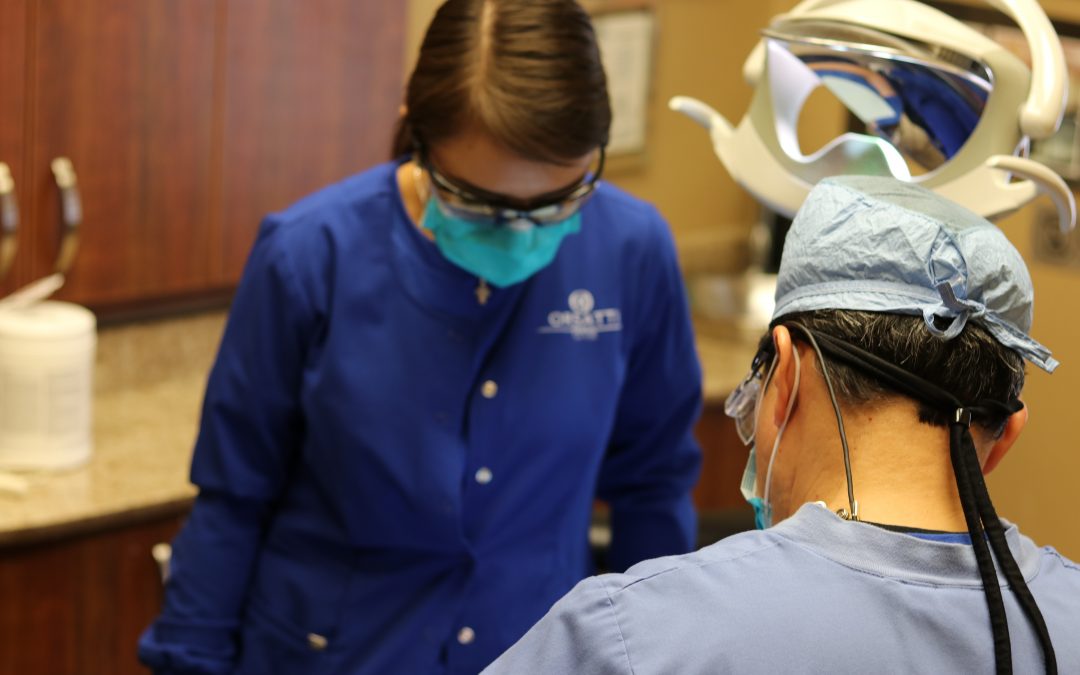San Antonio Dental Implants Basics and Procedures
What does your smile say about you? If you can grin ear to ear and feel great about yourself, that’s fantastic! Unfortunately, for many people, smiling only lowers their self-esteem and confidence levels. In fact, they might try to avoid smiling because they are unhappy with their teeth.
When it comes to dental restoration, dental implants have become the gold standard. In addition to being visually appealing, implants have the same functionality as your own teeth.
If you’re considering dental implants, read on to learn more about what they are and how they can benefit you:
What are Dental Implants?
Dental implants are a surgical procedure that replaces your missing teeth with screw-like posts constructed of metal. The artificial teeth that look and function natural teeth without ever having to be removed.
Having dental implants is a welcome alternative to bridgework or dentures, which are often ill-fitting or slip out. Implants are also a viable option when there aren’t enough natural teeth to attach bridgework.
The type of dental implant surgery depends on the condition of your jawbone, the type of implant being used and what your dentist finds upon examination. While some patients only need one dental implant, others may need multiple. If you have dental caries, your dentist will either have to fill them or remove the tooth before proceeding with dental implants.
The type of dental implant surgery depends on the condition of your jawbone and the type of implant being used. The actual process can involve several different procedures.
For example, you could need tooth extraction prior to dental implant surgery. In addition, the area where the dental implant is being placed also needs to be prepped. Since the area of the implant needs to heal properly to hold the implant securely, the process can take several months for your dentist to complete.
Dental Implant Procedure and What to Expect
Performed as a stage out-patient procedure, the process of having dental implant will vary between patients. However, some of the most common steps of dental implants include:
- Diseased tooth removal.
- Jawbone preparation.
- Bone healing and growth.
- Placement of abutment
- Artificial tooth insertion.
Jaw Bone Grafting
If your jawbone is too soft or not thick enough, you might require jaw bone grafting prior to getting implants. Because of the force that goes into chewing, the dental implant will not stay secure if your jawbone isn’t stable. Bone grafts create a strong foundation for your implants.
There are several types of bone grafting materials used to rebuild your jawline. One option is using natural bone grafting from another location in your body. In addition, there are also synthetic types of bone grafts that can be used like bone substitute, which is just as strong as natural bone. Be sure to talk to your dentist about which option is best for you.
Whether natural bone or a bone substitute is used, it can take several months for the transplanted bone to fuse. If you only need a minor amount of bone graft, that may be performed at the same time as the dental implant. However, the condition of your jawbone will determine how your dental implant procedure is performed.
Dental Implantation
Once your jawbone is deemed ready for implantation, your dentist will make an incision in your gum to expose the bone. Holes are then created in the bone where the metal post of the dental implant will be placed. Since the posts function like a natural tooth root, the post will be placed deep into the jawbone.
After this is completed, you’ll still have a gap where the missing teeth are. If needed, your dentist may give you a partial denture. Partial dentures are removable for cleaning and sleeping.
Once the post is secure in your jawbone, the osseointegration process will begin, During this time, your jawbone will grow and eventually unit with the surface of your dental implant. This process will take a few months but provides a solid foundation for your new teeth., just as the roots for your natural teeth do.
After osseointegration is complete, you might need additional surgery prior to placing the abutment. An abutment is a piece where the crown is attached. This part of the process is considered minor surgery and is usually performed under local anesthesia as an outpatient.
To successfully place the abutment, your dentist will reopen your gum to expose the implant. Then, the abutment is attached to the dental implant and then gum tissue is then closed around the abutment. In some instances, the abutment will be implanted post when the post is implanted in your mouth. Keep in mind that since the abutment is just past the gum line, it will still be visible when you open your mouth.
Some patients don’t want the abutment being visible, so they prefer to have their abutments placed in separate procedures. After your abutments are placed, your gums will need time to heal for at least two weeks before a dental implant is placed.
Choosing the New Teeth
Once your gums are healed, you’ll then have additional impressions made of your mouth. The impression will be used to make your crowns, which are the artificial teeth. Remember, that the crown can’t be placed until your jaw is strong enough to support the new teeth. When it comes to choosing the artificial teeth, you can choose between fixed, removable or a combination of the two:
Fixed
These artificial teeth are either cemented or permanently screwed into implant abutments. These cannot be removed. In most cases, each crown is attached to its own individual dental implant. These types of implants are very strong and can replace several teeth at one time when bridged together.
Removable
Removable teeth are similar to traditional removable dentures. These types of artificial teeth are surrounded by plastic gum, which looks like your own gums. These are mounted onto a metal frame that’s attached to the implant abutment. It is then snapped into place but can be removed for cleaning and repair.
Endoseal
Fused into the bone, this is the most commonly used type of implant. Designed to hold one or more teeth, this type of implant is typically used for patients with removable dentures or bridges.
Subperiosteal
Subperiosteal implants go on the bone. They are placed on top of the jaw with the posts protruding through the gum to hold the prosthesis in place. This type of dental implant is used mostly in patients who cannot wear dentures or have minimal bone height.
After the Procedure
Whether it’s done in one sitting or in multiple stages, it’s not uncommon to experience the following discomforts:
- Pain at the site of implantation
- Swelling and tenderness
- Bruising of skin and gums
Depending on your dental picture, you may have to take antibiotics or pain medication. If swelling and pain do not resolve or worsens, you need to contact your dental professional immediately.
Suitable Candidates for Dental Implants
Most people consider dental implants to replace missing teeth. While dentures or bridges are still viable options, implants are the closest thing to your natural teeth. Dental implants can boost your self-confidence, especially for patients who struggle due to missing teeth.
The best candidates for dental implants are in overall good health. They also have realistic expectations of what dental implants can do.
In addition, your gums also need to be healthy and free of periodontal disease. If not, your jaw and gums will not be able to support the implant. It also puts you at risk of infection. If you are suffering from gum disease, this will have to be resolved prior to starting dental implantation.
However, you should consider dental implants if you:
- Are missing one or more teeth.
- Have overall good dental health
- Don’t have underlying conditions that will affect bone healing
- Do not smoke
- Have realistic expectations of what dental implants can do
Contraindications to Dental Implants
While implants are considered safe for most patients, they’re not for everyone. There are situations where receiving implants should be avoided. People who suffer from bleeding disorders, cancer, leukemia or are immunocompromised are not suitable candidates. In addition, pregnant women and patients under the age of 18 should not undergo dental implantation.
What do Expect After Treatment
Once you’re fully recovered, you’ll need to treat your dental implants the same way you care for your own teeth. In addition to brushing twice a day and flossing after eating, you also need to see your provider on a regular basis. Proper follow-up visits will ensure that your gums remain healthy and your implants are functioning properly.
Dental Implant Tips
To keep your dental implants looking new, there are a few things you should do. In addition to proper oral hygiene, what you eat is equally important. For example, chewing on ice or hard candy can break the crowns of your implants.
In addition, avoid teeth-staining food and drinks like wine, tea and coffee. You should also avoid tobacco. If you have a habit of grinding your teeth, talk to your dental professional about ways to break the habit. Usually, they can create a retainer that you wear at night.
Finding a Local San Antonio Dentist
If you’re in San Antonio and considering dental implants, it’s important to find a dentist in San Antonio that you can trust. Even when performed as an outpatient, dental implantation is a surgical procedure. As such, you need to make sure you’re in the right hands.
Before having any dental work performed, schedule an initial consultation with a San Antonio dentist. Make a list of questions and concerns you may have. A qualified dental professional in San Antonio should be able to answer your questions completely. In addition, ask to see before and after photos of previous patients.
Most dentists in San Antonio who perform dental implants are more than happy to share their work with you. If they refuse, or if they have limited experience, it’s a good idea to look elsewhere.
The same holds true about the cost. While everyone wants to save money, rock-bottom prices for dental implants in San Antonio do not exist. Sure, your San Antonio dentist may offer to finance or even give you a reduced rate, but if the price is too good to be true, move on.
Located in San Antonio, the dental experts at Orsatti Dental have many years of experience in both dental implants, routine dentistry and dental restoration. If you’d like more information about what dental implants can do for you, contact Orsatti Dental in San Antonio today. The smile of your dreams is just a phone call away.
Orsatti Dental is a San Antonio Dentist office, serving all of San Antonio! Orsatti Dental is located at 15303 Huebner Rd, San Antonio, TX 78248.
Contact Orsatti Dental in San Antonio to learn more dental care, or to schedule an appointment with us!


